Child Care Health And Safety Guidelines
Introduction to Child Care Safety
Parents and guardians always want the best for their kids. Child care can be scary. You want to know your child is safe and healthy when you’re not there. This guide is here to help you.
Let’s begin understanding how to create a safe place for kids.
Why is Health and Safety Important in Child Care?
Keeping kids safe and healthy is vital for their growth. Let’s look at why this is super important:
- Safety First: Protecting children from danger is necessary in any childcare place.
- Health Matters: A clean place stops germs from spreading.
- Happy Kids: Children who feel safe can play and learn better.
- Peace of Mind: Parents worry less when they know their children are in good hands.
Critical Guidelines for a Safe Child Care Environment
Now, let’s dig into the steps to keep children safe. These guidelines are simple yet very important!
| Area | Guidelines |
|---|---|
| Space Safety | Make sure that the place is not too crowded. Too many things can cause falls or accidents. |
| Toy Safety | Only have toys that are right for the age of the child. Check that all toys are safe to play with. |
| Hazard Check | Remove things that can hurt kids, like sharp edges or small objects they could swallow. |
| First Aid | Always have a first aid kit ready. Know how to use it and keep it out of kids’ reach. |
Essential Health Practices in Child Care
Keeping kids healthy involves more than just safety. Here are some tips to keep germs away:
- Clean Hands: Make sure everyone washes their hands often.
- Disinfect: Clean all surfaces and toys every day. Use safe and effective cleaning products.
- Stay Home if Sick: If a child feels wrong, they should stay home. Sick kids can make other kids sick, too.
- Healthy Eating: Give kids healthy food that will help them grow strong.
Child Care Providers: Health and Safety Training
Caring for kids means constantly learning. Childcare providers should be trained in health and safety. This training can include:
- First Aid and CPR
- Infection Control
- Food Safety
- Emergency Procedures
This training will prepare them to care for their little ones.
Creating a Safety Plan
Every childcare place needs a safety plan. This plan shows how to keep children safe at all times. It talks about things like:
- Fire Drills: Practice leaving quickly and safely if there is a fire.
- Lockdown Procedures: Have a plan for when it’s not safe to go outside.
- Medical Emergencies: Know what to do if a child gets hurt or feels sick.
Good planning ensures everyone knows what to do when there’s a problem.
FAQ: For Child Care Health And Safety Guidelines
What Are Key Child Care Safety Protocols?
Childcare environments prioritize the safety of little ones by implementing strict safety protocols, including regular facility inspections, sanitized play areas, and ensuring secure sleep environments. Staff members are also trained in first aid and emergency response to provide quick and effective action.
How do you promote health in Childcare Settings?
Promoting health within childcare settings involves:
- Advocating for proper handwashing techniques.
- Requiring up-to-date immunizations.
- Overseeing the preparation of nutritious meals.
Regular physical activity and health screenings are also integral to maintaining the well-being of children.
What Guidelines Apply To Child Care Sanitation?
Childcare sanitation guidelines mandate regular cleaning and disinfection of toys and surfaces, appropriate diapering practices, and the isolation of sick children to prevent the spread of illness. Establishing routines that uphold strict hygiene standards is essential to ensure a healthy environment for children and staff alike.
Health and safety in child care is super important. Following simple steps can keep children safe and sound. With the proper care, kids can play, learn, and grow daily.
Remember, we share the responsibility for children’s safety. By working together, we can make sure they have a happy childhood.


